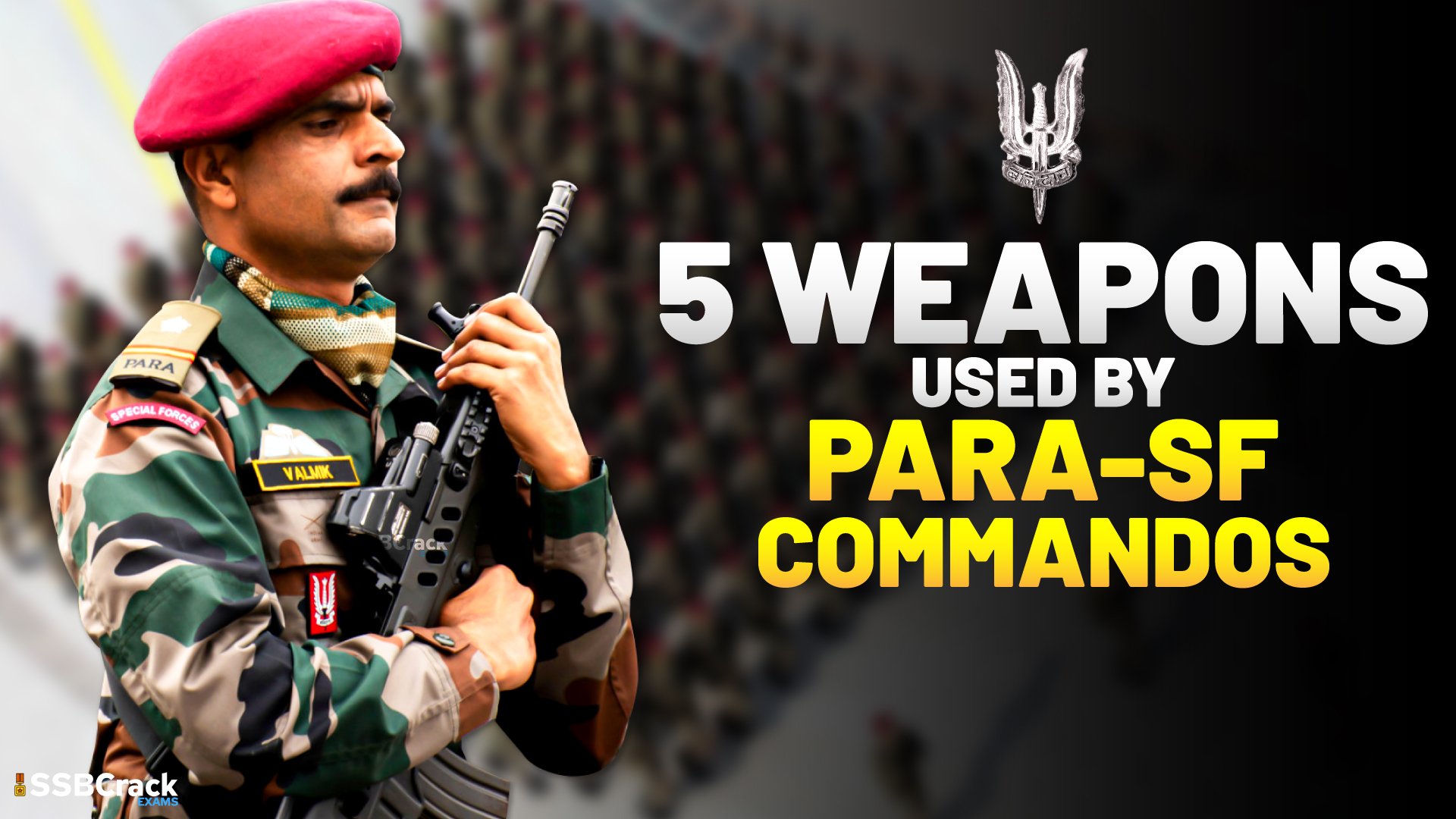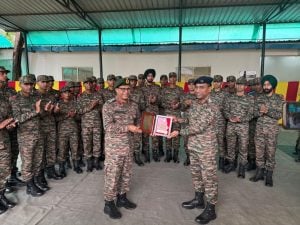PARA SF commandos have been part of our counter-terror and counter-insurgency operations for a long time now. They fight enemies across terrains, and carry out secret reconnaissance operations. Their expertise has been proven time and again through various operations ranging from the 1971 War to the much celebrated Surgical Strike.
We can readily infer that their mode of operation requires a certain amount of technological sophistication , particularly with regard to their firearms and ammunition. They are supplied with the deadliest of weapons and equally tough equipment. Check out 5 weapons reportedly used by PARA-SF Commandos:
Heckler and Koch MP5
Tilo Möller, Manfred Guhring, Georg Seidl, Helmut Baureuter, Rudolf Brandl, Herbert Doll, Paul Thevis, Helmut Danner, and Erich Weisser conceived the Heckler & Koch MP5 (Maschinenpistole 5, lit. “submachine gun 5”) in 1964 and it has been manufactured by Heckler & Koch since 1966. The MP5 is one of the most extensively used submachine guns in the world, having been acquired by over 40 countries.
The MP5 is a shortened variant of the G3, chambered in 9mm Parabellum. It uses the G3 action’s core principles and shoots from a closed bolt. All MP5 SMGs are equipped with fire control groups that can fire in a variety of modes. The three-positional, which has safe, semi-automatic, and full auto positions, and the four-positional, which has safe, semi-automatic, burst, and full auto positions, are the two primary varieties. Burst mode lets you fire two or three bullets in a single pull of the trigger- two or three depending on the exact model.
IMI Galil
Israel Military Industries (IMI) created the Galil, an assault rifle. The Galil weapon is based on the Finnish Rk 62 rifle, which is a derivation of the Kalashnikov rifle, and has many characteristics of it. The fundamental concept for the Galil design came from a primitive early prototype known as the “Balashnikov.”
The receiver is made of thick machined steel and is designed to handle the high pressures of NATO cartridges. To avoid corrosion, all exterior metal surfaces are parkerized. Unlike the AK-47, the charging handle is located at the top of the receiver cover (pointing upward), making it simpler to charge the weapon with your left hand. The Galil has the same operational mechanism as the Kalashnikov: the actuator rod is permanently linked to the bolt carrier, and when a bullet is fired, the gas impinges on it, forcing the bolt carrier back and rotating the bolt to free it. The bolt conducts a main extraction movement on the spent casing after unlocking, assuring positive extraction and ejection.
IMI Galils are shoulder-fired, gas-operated select-fire guns. They feed from 35-round box magazines. The magazine is put into the magazine well using a “rocking” action, with the lug on the front of the magazine engaging with its recess in the magazine well. It should be yanked backwards until it clicks into place. The selector must be turned off safely in order to activate the charging handle. To chamber a round, the charging handle is drawn all the way to the back and then released. The bolt will remove a cartridge from the magazine and feed it into the chamber as the bolt carrier group moves forward.
M4 Carbine
The M4 is a carbine derivative of the AR-15 used by military forces across the globe. It is derived from the M16 assault rifle used by the US military. Manufacturers have evolved in response to defence contracts over time. Colt produced the initial M4s, which were later supplemented by Fabrique Nationale.
There are many variants for the M4 Carbine like M4, M4A1. M4 type has a collapsible stock, a carbine-length gas system, shorter handguards, and a 14.5-inch barrel with a notch to support the M203 underbarrel mounted grenade launcher, and was introduced in 1994. M4 feed ramps are included in the barrel assembly; unlike rifle feed ramps, which are inclined at 45 degrees, the M4 feed ramps are longer and somewhat steeper (52 degrees) to improve carbine system dependability. In addition, the front sight block is somewhat higher (“F” marked). SAFE, SEMI, and BURST are the three positions in the FCG. The A2 upper receiver was used on the first versions, but flat-top variants have since superseded it.
In the M4A1, FCG is the same as the M4, except the BURST FCG contains AUTO components instead of the BURST FCG. In addition, the M4A1 features a heavier SOCOM profile barrel, as compared to the M4’s Government profile barrel. The majority of M4A1 models were modified from M4s. They were nearly solely provided by Remington, but Colt objected and won over 88 million dollars to keep the contract, which is still in place with the US government, with the intention of letting additional businesses to supply M4A1s. Fabrique Nationale is currently supplying them as well.
IWI Tavor
IMI created the Tavor TAR-21 assault weapon to replace the Galil, M16A1, and CAR-15 assault rifles. The Tavor was designed to be a highly dependable assault rifle that could be used in urban settings. It was given the moniker TAR-21, which stands for “Tavor Assault rifle for the Twenty-First Century.” The Tavor is a next-generation Infantry Weapons system that combines the finest of contemporary firearm technical achievements into a single device. The Tavor is a bullpup polymer weapon with all of the weight against the shoulder enabling speedier movement in urban situations, which troops encounter more frequently.
While maintaining full barrel length, the Tavor is significantly shorter than prior assault rifles. The TAR-21 is available in 5.56mm NATO and 9mm calibres. The Micro Tavor model comes with a silencer and may be chambered in 9mm. The Tavor features a 30-round magazine and is NATO Stanag compatible. The Tavor may be equipped with the same accessories as other assault rifles. The rifle comes with a built-in MARS reflex sight on the barrel, however it can be replaced with any sight. The addition of a night sight or magnification without re-zeroing the sight is possible with this integrated sight.The Tavor is also incredibly dependable, featuring over-the-beach capabilities that let it to fire without exploding even while immersed in water.
PGM 338
The PGM 338 was created by AMSD’s Chris L. Movigliatti to bridge the gap between the 7.6251mm NATO marksman rifle’s lack of stopping power and the.50 BMG sniper rifle’s lack of mobility. It’s made to go up against the SAKO TRG and the Accuracy International Arctic Warfare. PGM Précision in France, Drake Associates, Inc. in the United States, and Liemke Defense in Germany distribute it.
The PGM 338 is based on a central girder metal chassis. This gives it a unique barebones aesthetic, which is meant to make it easier to maintain. The receiver is composed of 7075 aluminium, with three locking lugs on the bolt and several overpressure vent holes on the receiver to assist vent high-pressure gases in the unlikely event of a cartridge case head failure. The cold hammer-forged barrel is made by Lothar Walther and has a detachable muzzle brake; PGM suggests using the muzzle brake or a silencer at all times to maintain shooting comfort.The weapon has polymer furniture and a trigger pull that may be adjusted. It has a Picatinny rail that may be used to install a variety of lenses. A bipod is affixed to the bottom of the PGM 338, and an extra monopod is added to the stock. It has a 0.5-minute precision in angle measurement.
Also Read:
The readers can subscribe to SSBCrackExams to get more informative articles in their feed. All the best.
To crack the SSB Interview, NSB interview and AFSB interview, You can join our SSB interview live classes batch and we recommend you to Enroll SSB INTERVIEW ONLINE COURSE. Trusted by thousands of defence aspirants.



























4 thoughts on “5 Weapons Used By PARA-SF Commandos”
This was an insightful post! I had no idea about the variety of weapons utilized by PARA-SF Commandos. It’s fascinating to see how each weapon serves a specific tactical purpose. The blend of traditional and modern technology is particularly impressive. Thanks for sharing this detailed look into the armory!
This is a fascinating read! The detail about the weapons used by PARA-SF Commandos really showcases their advanced training and the high stakes they operate under. It’s impressive how each weapon is chosen for a specific purpose in different mission scenarios. Would love to see more posts covering the training and tactics involved as well!
Great post! It’s fascinating to learn about the specialized weapons used by PARA-SF Commandos. Each weapon seems perfectly suited to their unique missions. I’m particularly interested in how they adapt their gear based on mission requirements. Thanks for sharing such detailed insights!
Great insights! It’s fascinating to learn about the specialized weapons used by PARA-SF Commandos. Their selection really reflects the demands of modern warfare. I especially found the details about the versatility of their firearms intriguing. Would love to see more about their training and operational tactics in future posts!